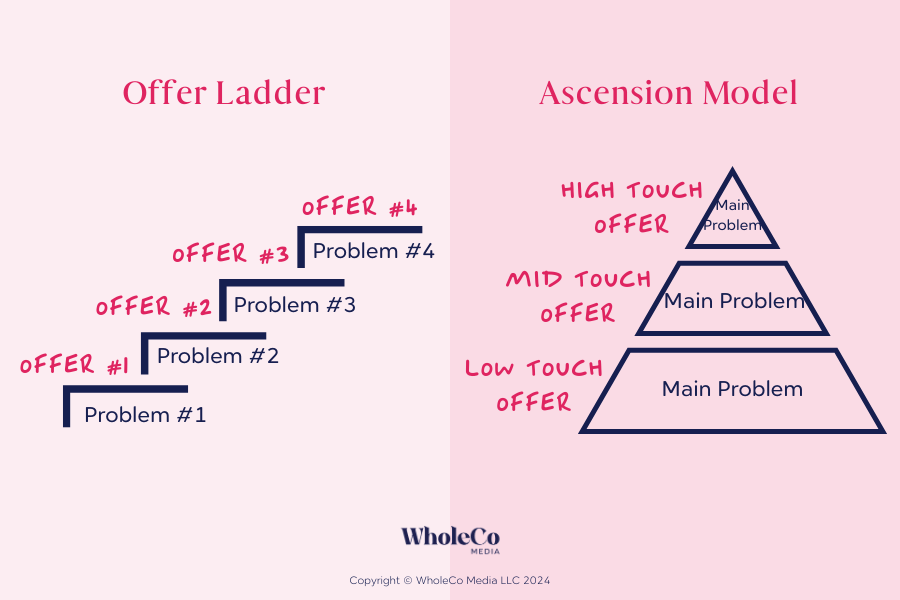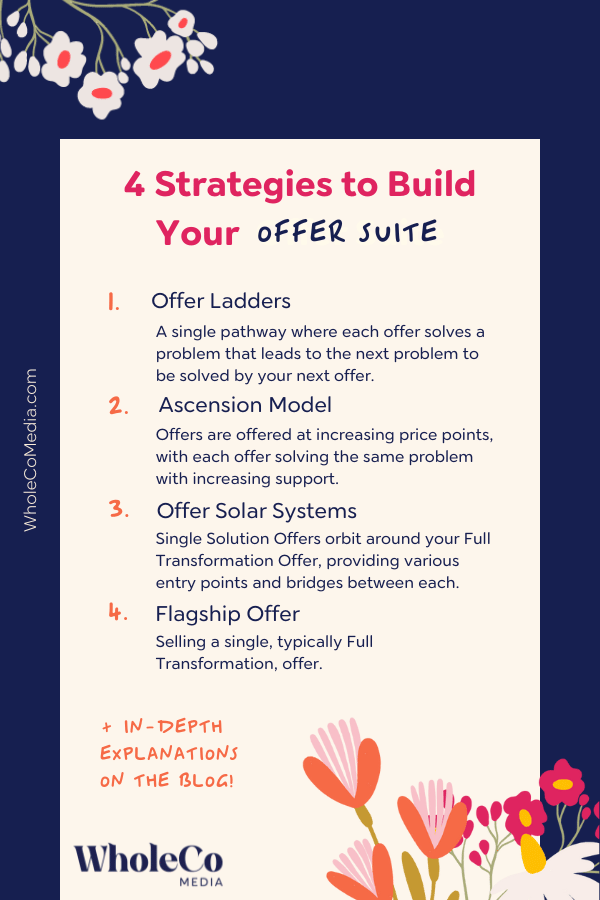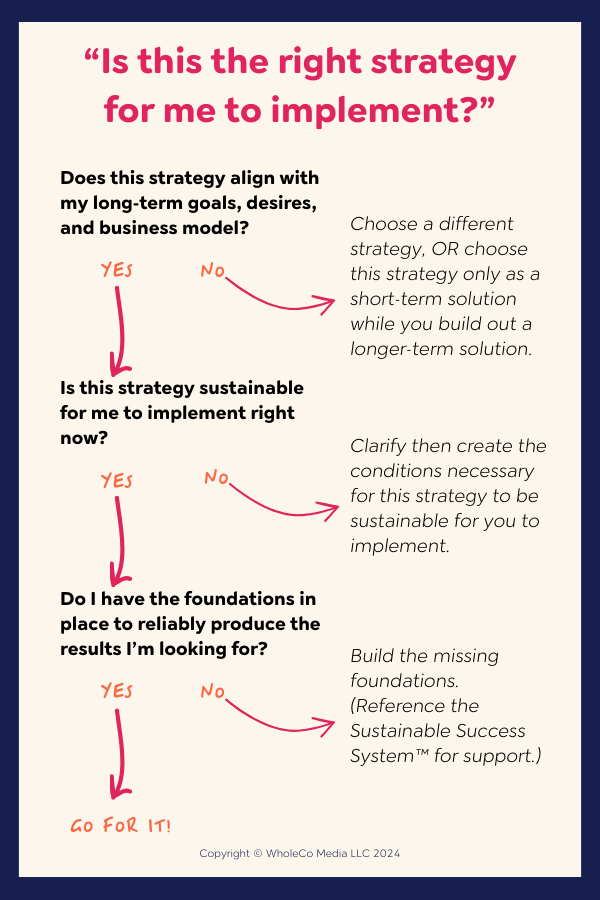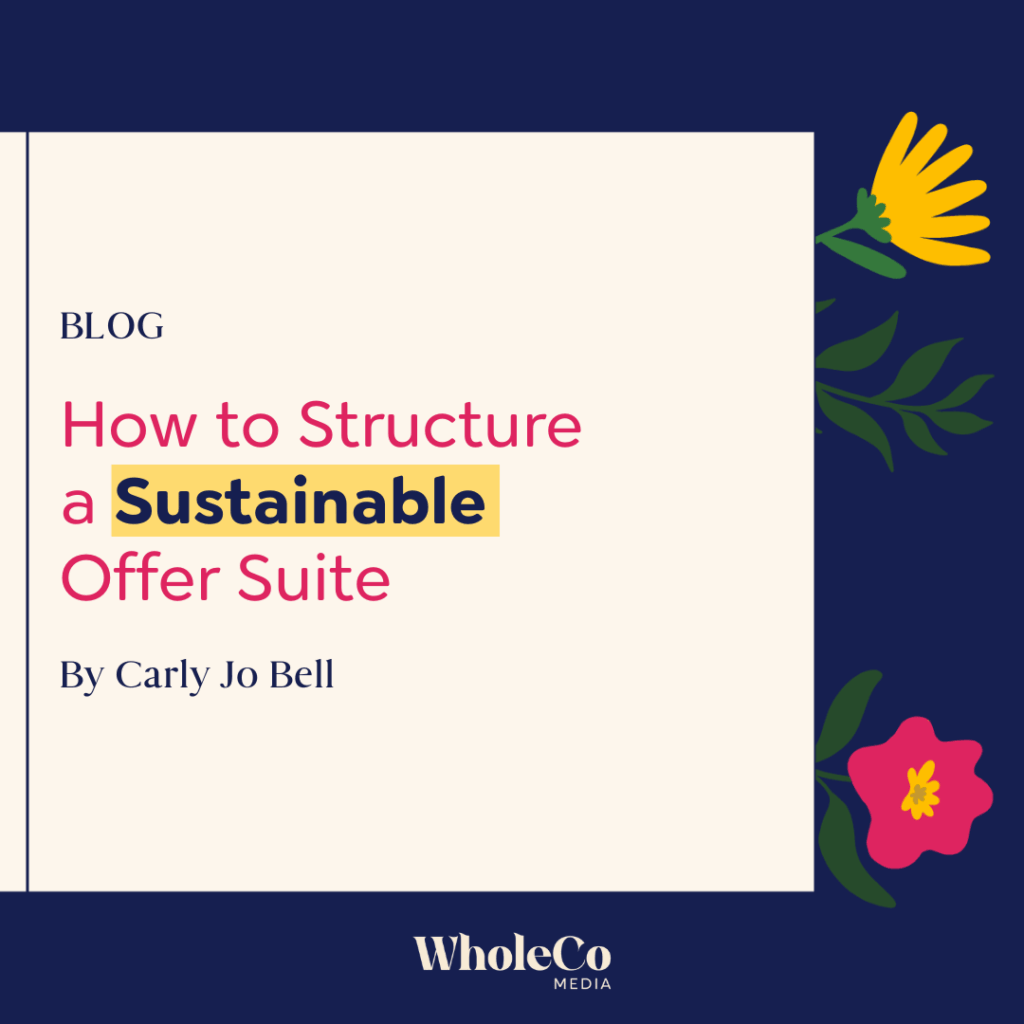When it comes to developing an offer suite as an online service provider, coach, course creator, or other practitioner, you’ve likely heard a fair amount of conflicting advice.
For example —
“Just focus on ONE offer!”
“You need an offer ladder with products at every price point to move people up to your premium services!”
While both of these strategies for designing an offer suite can work, they are just that: strategies. And where there is one strategy, there are hundreds if not thousands more, all of which could move you toward your goals. How, then, do you choose which strategy to use to design your offer suite?
Well my friend, you’re in the right place, because I’m going to equip you to answer that question for yourself right here in this blog post.
This page may include affiliate links, which means that if you choose to make a purchase, I may earn a commission. This commission comes at no additional cost to you.
What is an offer suite?
Let’s first get one thing clear: an offer suite is essentially a set of products, services, and/or packages that your customers can buy. Which offers and how many you need in your offer suite is largely determined by your business model and financial goals. However, once you have a broad idea of what your offer suite needs to look like—from a sort of “birds eye view” of it—you need to choose the actual offers that you’ll have in your offer suite.
Note: there might be a “right now” group of offers that you’ll have in your offer suite, and a “one day” group of offers that you’ll eventually add to your offer suite when it becomes sustainable to do so.
Before you can choose which offers to include in your offer suite, there’s one significant piece of contextual information that you need to understand: the two types of offers.
The Two Types of Offers
We go a lot deeper on the two types of offers in this blog post, but here’s a brief overview as you must understand the two types of offers in order to design a sustainable offer suite.
There are two types of Right Fit, purchase-ready clients. These are:
- Solution-Oriented Client: seeking a single solution to what they perceive as being a single problem
- Transformation-Ready Client: seeking a holistic solution to what they understand is a deeper, more core problem.
If these are the two types of Right Fit, purchase-ready clients, then naturally, we want to create offers to sell to both of them. By having offers that are designed to meet these two purchase-ready clients in the exact moment they’re ready to buy, you will make sales of those offers with a heck of a lot more ease and simplicity.
That means there are two types of offers. These are:
- Single Solution Offers: which provide a single, specific solution for a single, specific problem for our Solution-Oriented Client
- Full Transformation Offers: which provide a holistic solution to fully solve a core problem for our Transformation-Ready Client
Often when people hear “types of offers,” they think about things like: done for you services, group programs, masterminds, courses, etc. What all of those really are, however, are Delivery Structures. Pretty much all of those Delivery Structures could be designed either as a Single Solution Offer or as a Full Transformation Offer in order to position it as an “obvious yes” for your Right Fit clients.
“Do I need both types of offers in my offer suite?”
Having both of these types of offers in your offer suite makes it so that you can serve clients at each stage of their journey that they’re actively seeking out support. It also means that your business will be more sustainable in terms of revenue creation, because you’re able to invite clients into more than one offer—e.g. Solution-Oriented Clients who join a Single Solution Offer can later be invited to move into a Full Transformation Offer (when they are a Transformation-Ready Client). Keeping a client requires significantly less effort (and money!) than getting a new one, which is why clients signing up for a second, third, fourth, etc. offer has the potential to provide a lot of revenue stability and profit.
Having both types of offers doesn’t only benefit you and your business, though, it also benefits your Right Fit clients. That’s because, when done well, you as the business owner can use your Single Solution Offer to support clients in skipping over the Phase 3, “Looking for a savior” phase. This is a natural, but uncomfortable phase of growth and transformation, that often occurs because people “don’t know what they don’t know.” In your Single Solution Offers, you can show them what they don’t know (the full context of the single solution you’re providing) and effectively “build a bridge” for them to simply become Transformation-Ready.
Common Strategies for Designing Your Offer Suite
There are a LOT of different strategies for designing an offer suite. What you need to know about most of them is that you’ll typically want to have at least one Single Solution Offer and one, maybe two Full Transformation Offers. The typical online coaching, consulting, service providing, teaching, and/or practitioner businesses will only have one Full Transformation Offer in their offer suite. This is largely because most of these business owners have one core, holistic transformation they have both the experience and expertise to reliably facilitate.
The primary time that you might choose to have more than one Full Transformation Offer is if your transformation is quite a large one, and it’s therefore broken down into either a Part 1 and Part 2 offer—e.g. Applied Depth Institutes’ Sacred Depths, which is part 1, and Advanced Depths, which is part 2—or it’s a transformation that benefits from ongoing maintenance, and so you have a Full Transformation Offer and a “maintenance offer.” (Maintenance offers are typically not marketed to the public, so I do not have examples I can show you of this set up.)
With that, there are several common strategies that people use to structure their offer suites to include both Single Solution Offers and Full Transformation Offers. These are:
#1 – Offer Ladders
Where you have a single pathway through your offer suite, starting with solving one problem, which then leads you to the next problem you need to solve in the next offer, which leads you to the next problem you need to solve in the next offer, etc. The ‘lower rung’ offers will typically be Single Solution Offers, while the ‘higher rung’ offer/s will be Full Transformation.
True offer ladders are great on paper in that they create a very logical pathway for your people to step into and follow. However, I find that their shortcomings tend to outweigh their benefits. The biggest shortcoming being: the way that most offer ladders are implemented tend to require people to follow an explicit path in an explicit order, and make it quite challenging for people to jump ahead directly to an offer they are, indeed, ready for, despite it being a step or two ahead in the offer ladder. As an example: if your lowest rung offer is an e-book on how to find your business differentiator, and then your second rung is a course on how to craft messaging, and then your third rung is a group program that supports you to build and write copy for your own website, some people might want to skip over rung #2 and go straight to the group program from rung #1. But the way that many offer ladders are set up, you’re often only given the option of stepping into the very next rung.
Additionally, your Right Fit client might fulfill their Phase 2, Solution-Oriented phase of the Transformational Journey outside of your business, and then come to you when they’re in Phase 4, aka are Transformation-Ready. The way that many offer ladders are set up doesn’t really account for this, as the business owner expects that people will want to do the lower rung offer first, then progressively move up until they become Transformation-Ready. Which is why I recommend that if you’re going to do an offer ladder, you need to have all of your offers available to purchase and not require people to go from one offer to the next in order to access your full offer suite.
#2 – Ascension Models
A lot of people consider offer ladders and ascension models to be the same thing. Yet they actually have one crucial difference: offer ladders provide offers at increasing price points, where each offer solves a different, increasingly more complex problem. In an offer ladder, solving the problem in the first offer leads you to finding a new problem, which is solved in the next offer in the ladder. (I’ve seen some coaches refer to this as a “Problem-Solution Path,” though I can’t currently find any direct links to people talking about this.) Whereas ascension models provide offers at increasing price points, where each offer solves essentially the same problem, but with increasingly high-touch delivery. Basically, in an ascension model, a client is not necessarily paying more to solve bigger or at least different problems, they’re paying more for more access to the business owner or practitioner in question.

An infamous example of this is Tony Robbins (who, disclaimer, I am not a fan of). At the bottom of his ascension model “pyramid” are books and other smaller media assets (e.g. webinars), then you pay more for more access to him: attend his weekend seminar, join his group program, upgrade to the mastermind, and even eventually work 1:1 with him. (I found this blog post that talks more about Tony Robbins’ Ascension Model; note that I have not vetted this author whatsoever and didn’t do much beyond skim the blog post.)
Not all ascension models are inherently slimy, of course, but they do come with their own challenges and tradeoffs. For example, a service provider—we’ll use a copywriter for this example—might choose to have an ascension model. Their lowest price offer might be DIY (do it yourself), such as a website copy template. Then their mid tier offer could be DWY (done with you), like a group program where you’re guided to write your own website copy. Then their highest tier offer could be DFY (done for you), where the copywriter writes your website copy for you. Many service providers build businesses this way, yet many of them don’t realize: very different types of lead generation are often required to sell to a DIY-er as opposed to someone who wants DFY.
Where ascension models also cause some issues is that Single Solution Offers and Full Transformation Offers inherently cannot solve the same problem. This means that all of your offers in an ascension model would either be Single Solution Offers or Full Transformation Offers, but each is structured differently. Therefore, your messaging for each would need to be relatively the same, making the primary differentiator between your offers: how much support someone is getting and therefore the price point. This is where you’ll often run into pricing pushback—unless you either have a cult following, full of people who adore and trust you, specifically a la Tony Robbins, or you’ve nailed very intricate nuances in your messaging for each offer. This is simply for the fact that prospects are seeing several different paths to solving the same thing, but some paths are significantly more expensive than others. (“Why would I pay thousands for this when I could just do it for a couple hundred?”) Basically: you are now competing on price with yourself.
#3 – Offer Solar Systems
(Note: I first heard this phrase from Elizabeth Buckley-Goddard. I have not explicitly learnt her way of building “solar system” offer suites, which means that what I share below may or may not be exactly how she frames it.)
This is where you have a bunch of Single Solution Offers that all “orbit” around a Full Transformation Offer. I love offer solar systems (and in fact, have one here at WholeCo) because they allow humans to be humans and to make conscious investment decisions based on their own present lived reality, rather than on what you say is the next step that they “must” take (like in offer ladders). Additionally, they mitigate the issues of ascension models, since each offer stands independently of others and solves a different problem.
By having one core Full Transformation Offer that is sort of your “ultimate” offering—that’s EXPAND here at WholeCo!—you can then create Single Solution Offers that fully solve single, specific problems with a single, specific solution, within which you continually open the door for the client to step into your Full Transformation Offer when they’re ready to. Because there’s not necessarily a hierarchy amongst the Single Solution Offers, clients can start anywhere and move around to different offers as they see fit for their unique situation. Additionally, there also isn’t a feeling that clients must step into the Full Transformation Offer (or any other Single Solution Offer) in order to achieve what they set out to. Each offer stands alone, solving its own problem, yet each is interconnected. (Just like a solar system!)
As with anything, of course, there are tradeoffs to offer solar systems. One of which is: to do this well, you do need to be very intentional about consistently marketing each individual offer, which can take a fair amount of preemptive planning and ongoing effort. Otherwise, the offers that you aren’t marketing that often aren’t going to sell that often. You also need to be really effective at building “bridges” between your Single Solution Offers into your Full Transformation Offer. This requires a fair amount of intentional strategy at each stage of your offer development, marketing, sales, and delivery process.
#4 – Flagship Offer
Where you sell one offer, and maybe offer occasional upgrade opportunities within that one offer. Example: you have a membership that is your “flagship” offer, and then on occasion, you create an in-person retreat exclusively for members to attend. Typically, your flagship offer is a Full Transformation Offer.
The businesses I’ve seen thrive having only a flagship offer are practitioner or done-for-you service provider businesses who operate on referrals, are clear on their financial goals, and are not fixated on “scaling.” Think: the accountant and bookkeeper who is happy working 1:1 with clients and bringing in $150k top-line revenue per year. (If you read my recent blog post on choosing your business model, you’ll recognize this example as being a pure high-touch, low-volume business.)
For most business owners, it’s next to impossible to create a true flagship offer offer suite, because part of how they generate leads for their flagship offer is through Single Solution Offer/s (e.g. a paid workshop run quarterly to give people a taste of their approach, a free lead magnet that leads people into the flagship offer, etc.).

How to Choose Which Offer Suite You’ll Build
Which type of offer suite you’ll choose to build in your business really comes down to the needs of your business model and ultimately your own preferences. There isn’t necessarily a “right” or “wrong” offer suite.
When it comes to making any strategy-level decisions in your business, I always recommend that you ask yourself these three questions:
- Does this strategy align with my long-term goals, desires, and business model?
- Is this strategy sustainable for me to implement right now?
- Do I have the foundations in place to reliably produce the results I’m looking for?

Strategy Example: WholeCo Media
I’ll take you through my own journey with asking and answering these questions when deciding what strategy I wanted to use in developing my offer suite here at WholeCo.
From the beginning, I wanted to build an Offer Solar System (though I didn’t know that term at the time!). When I asked myself whether that strategy aligned with my long-term goals, desires, and business model, the answer was “yes, it does.” I’ve known for a while that I’m building a hybrid business model, leaning toward a more high-volume, low-touch business model. My goals and desires have always included that I do still get to work directly with clients, but on more of a “only when I want to” basis. I’ve therefore wanted the majority of my revenue to come from lower touch offers, which would free me up to do more of the visionary and business strategy work (which, goodness, I absolutely love).
So to question #1: Yes, having an Offer Solar System aligns with my long-term goals, desires, and business model.
Which means I can now move onto question #2: Is this strategy sustainable for me to implement right now? Looking back at a few years ago when I first began making decisions about my business model, the answer was: yes, so long as I implement this strategy in pieces. Hindsight is 20-20, and I can see clearly how in the past, I tried to do everything all at the same time. I tried to strengthen and systematize lead generation for our Full Transformation Offer (EXPAND) at the same time as creating and selling a bunch of different Single Solution Offers. Not only was this “everything all at once” approach exhausting, but it also meant that my attention was taken away from solidifying lead generation for EXPAND, and therefore not on solidifying an ongoing revenue source. That meant that my new courses and products were responsible for bringing in new revenue, which is a lot of pressure to put on new, lower cost offers.
Thankfully, it worked for me for a time. Until I got sick and then injured, severely limiting my capacity to do much of anything for about 9 months, and especially not to do both the lead generation systematization and the new offer building all at the same time.
To question #2, therefore, the answer was: yes, so long as I implement the strategy in pieces. But this isn’t what I actually did. (You live and you learn!)
Finally, question #3: Do I have the foundations in place to reliably produce the results I’m looking for? The biggest way to tell is: am I reliably bringing Right Fit, ready-to-buy clients into my offers, and are they reliably receiving the results I say that they will? This is an ongoing process, of course, but my answer to question #2 actually shows that, while I had most of my foundations in place—and I subsequently was bringing Right Fit clients into right-for-them offers and they were reliably getting results—I was missing something. Specifically, I was missing my lead generation foundations, which I can see because, again, I was not reliably bringing those clients in.
So, to answer question #3, no, I did not have those foundations in place. From the vantage point of today, I see that I would have been better served by first systematizing EXPAND lead generation, then individually adding new offers into our Offer Solar System. Then getting each Single Solution Offer fully set up, with systematized lead generation for it, too, before adding another new one in.
“Am I ready to implement an offer suite strategy?”
If you can answer “yes” to all three of these questions, then go ahead and start implementing your chosen strategy now. That would very likely mean, as a starting point, that you determine which offer suite strategy you’d like to implement, a broad overview of what offers you’ll want or need, and then begin building whatever the next offer is that you need for your offer suite.
However, if you have a “no” to any of those questions, then that tells you what you need to do first:
- If the strategy doesn’t align with your long-term goals, desires, and business model—you need to choose a different strategy. (Or, let a strategy be a “for right now”/”to make ends meet” strategy, while you begin implementing a different, longer-term strategy to eventually replace the “right now” strategy.)
- If the strategy is not sustainable for you to implement right now—you need to clarify what conditions would let you know that it is sustainable for you to implement this new strategy, and then support yourself to create those conditions. (e.g. if you want to implement an ascension model, but you currently have no extra time to dedicate toward creating a lower-ticket offer, such as a DIY course, then you need to first find a strategy for increasing your available time.)
- If you do not have the foundations in place to reliably produce the results you’d like to via this strategy—you need to build those foundations.
Building these foundations and then choosing which strategies are right for you, your business, and your audience is precisely what we do inside of EXPAND. EXPAND equips you with the skills and self-trust to embrace your role as CEO, systematically setting your business up for long-lasting Sustainable Success.
Learn more and join us inside of EXPAND here.
Want more posts like these? I send them out most weeks to my email list; get on the list in the form below.
Handy Links:

hey!
I’m Carly Jo Bell.
(Though you can just call me Carly.)
Carly Jo Bell is a business strategist and mentor, and fonder of Whole Co media. Through her courses and programs, podcast, and one on one coaching, Carly helps pulled-in-every-direction entrepreneurs create a business that brings in as much joy as it does revenue — by cultivating deep self trust, and solid foundations as the first step.
For more from Carly, and to learn about her signature “looking external for inspiration, and internal for answers” approach, join the conversation by signing up for her weekly email series, Carly's Couch.




